Abstract
Rhesus monkeys immunized intramuscularly or orally with staphylococcal enterotoxin B (SEB) toxoid or SEB toxoid incorporated in microspheres made of poly(DL-lactide-co-glycolide) were challenged with a lethal dose of aerosolized SEB to study their immunity and cellular responses in the circulation. It was found that circulating antibodies play a critical role in preventing SEB from triggering toxicosis. Monkeys with high levels of antibodies survived, while those with low levels underwent 2 to 3 days of toxicosis and died. Intramuscular immunization induced high levels and oral immunization induced low levels of antibodies. The circulating antibodies in surviving monkeys decreased dramatically within 20 min and started to rebound at 90 min after SEB challenge. At 90 min, the dying monkeys showed in the circulation a dramatic increase of polymorphonuclear leukocytes and decreases of NK cells and monocytes (CD16 and CD56 markers) as well as of lymphocytes with HLA-DR, CD2, CD8, and IL2R alpha (CD25) markers. The number of polymorphonuclear leukocytes showed an inverse correlation with the numbers of monocytes and various lymphocyte subpopulations which, except for IL-2R, CD16, and CD56(+) cells, showed a direct correlation with one another. The changes in the populations of leukocytes, monocytes, NK cells, and lymphocytes seem to be an indication of initial toxicosis; however, the roles of these cells in toxicosis and death remain to be defined.
Full text
PDF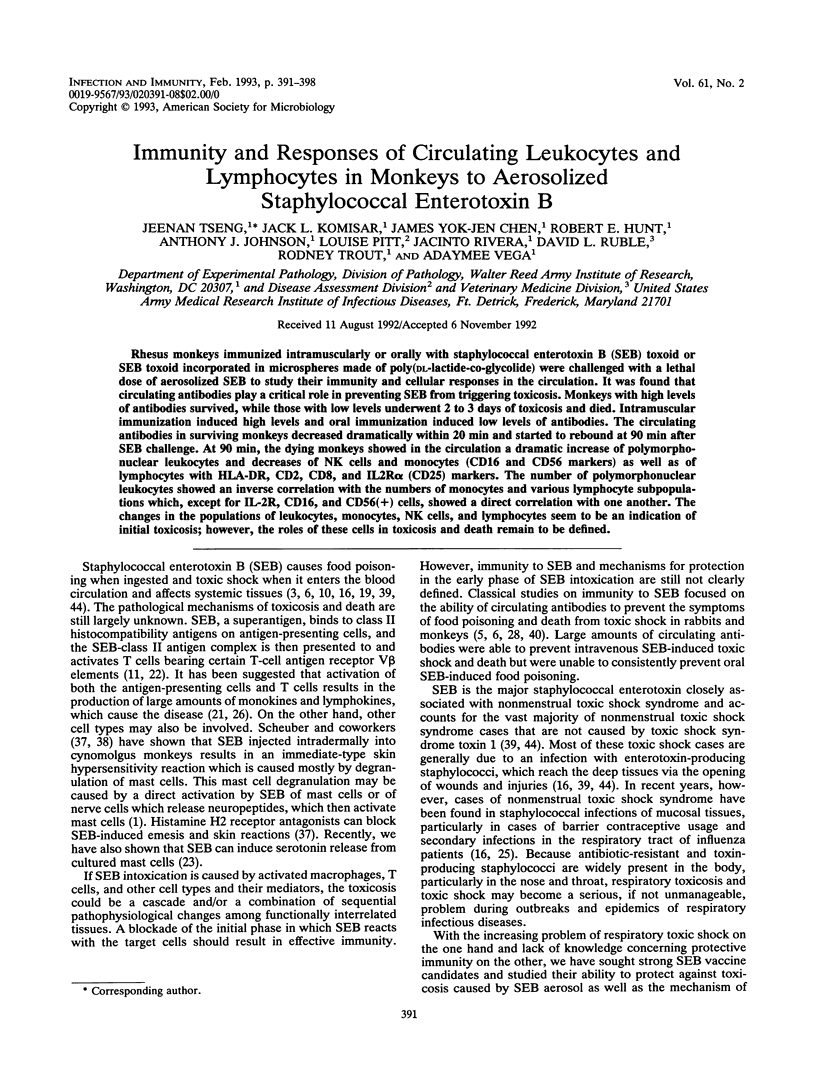
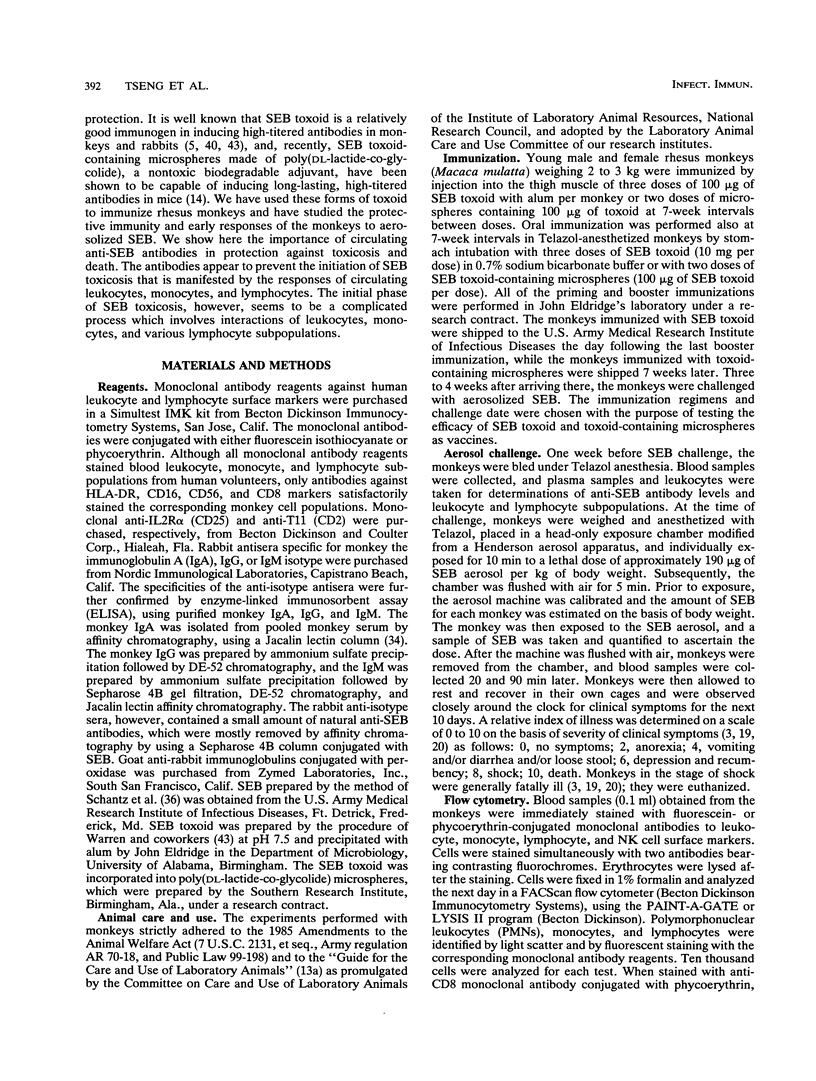
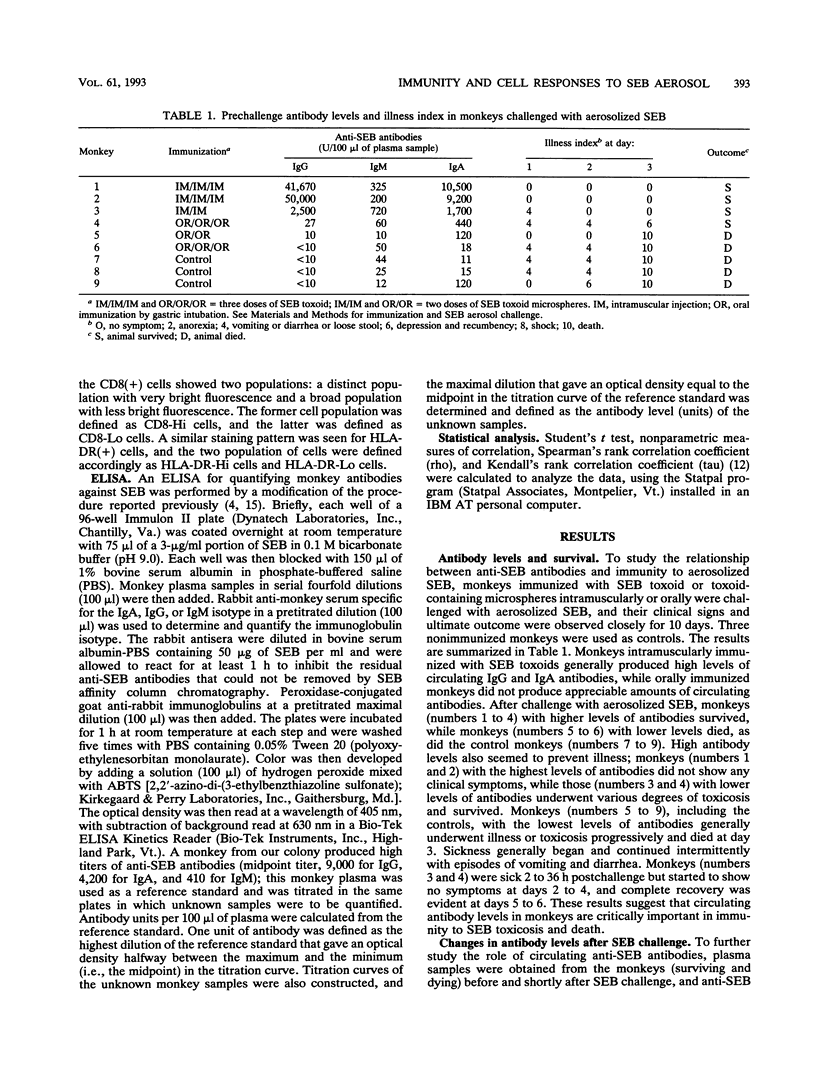
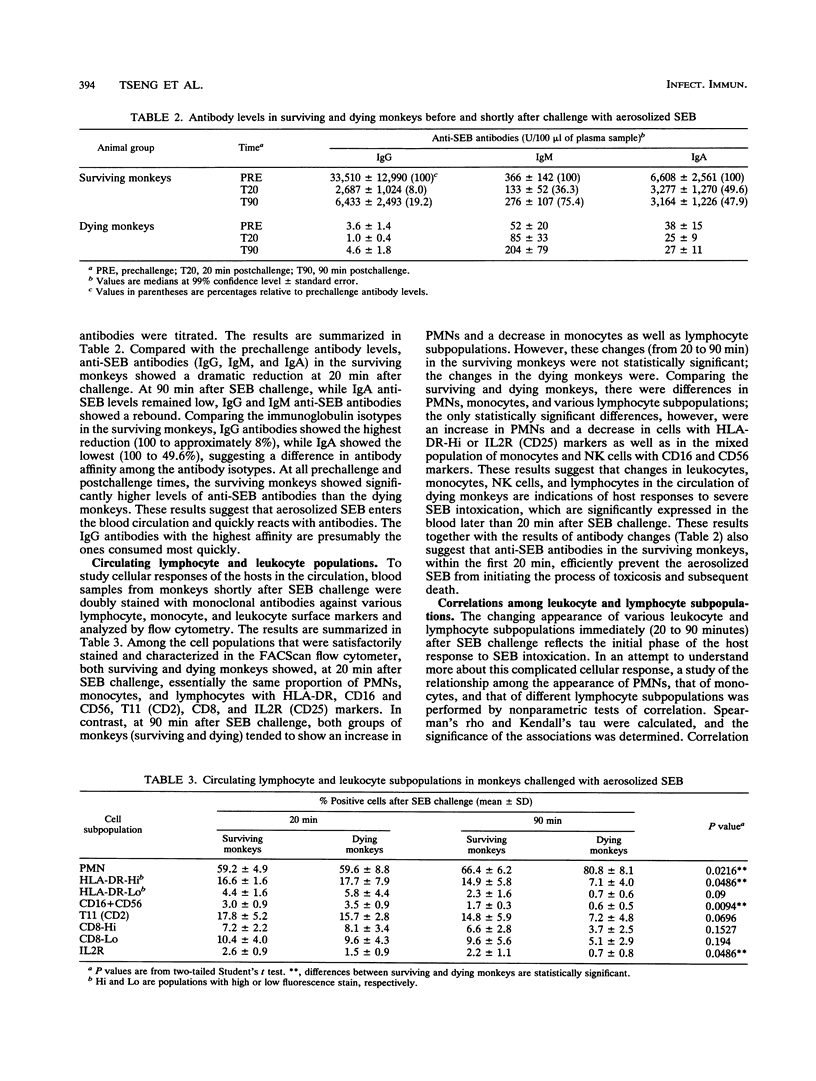
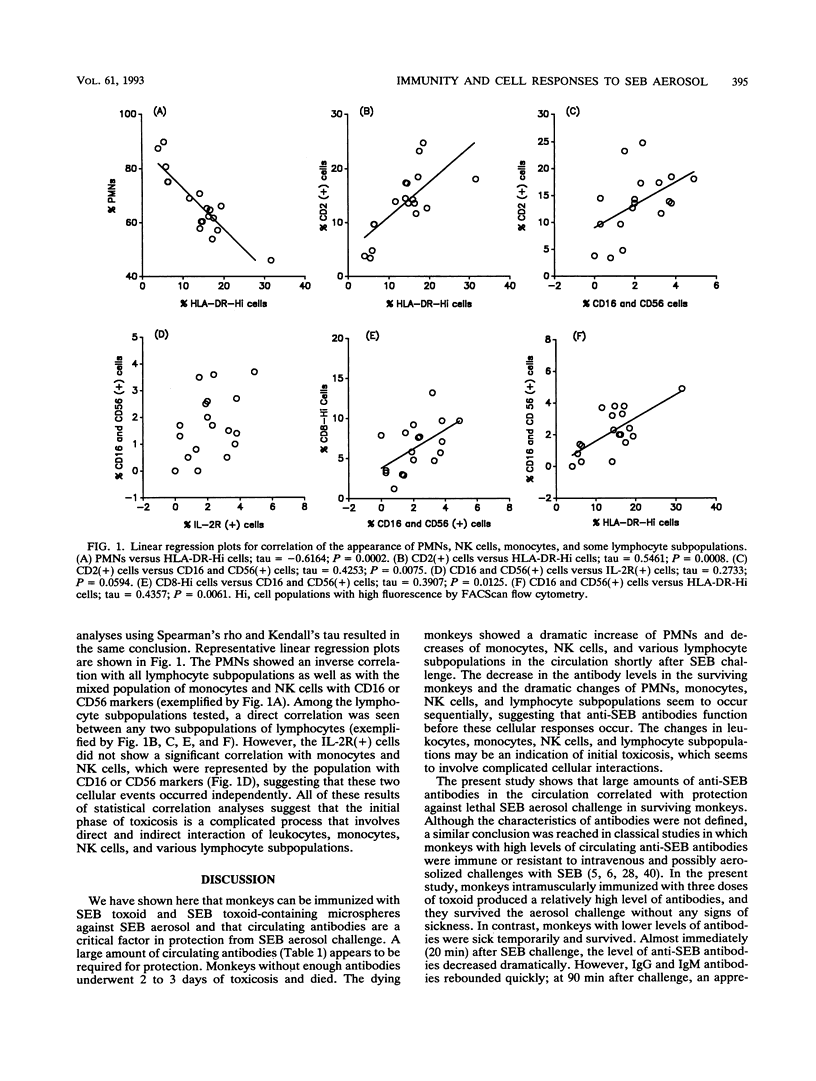
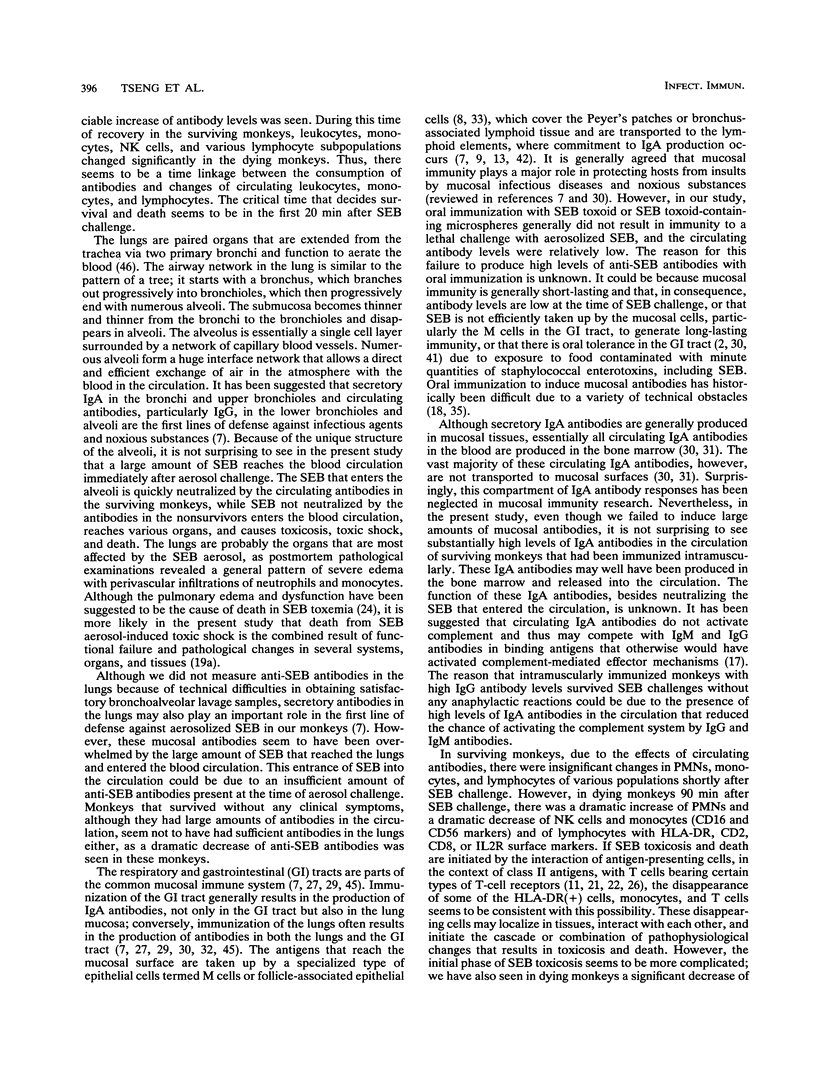
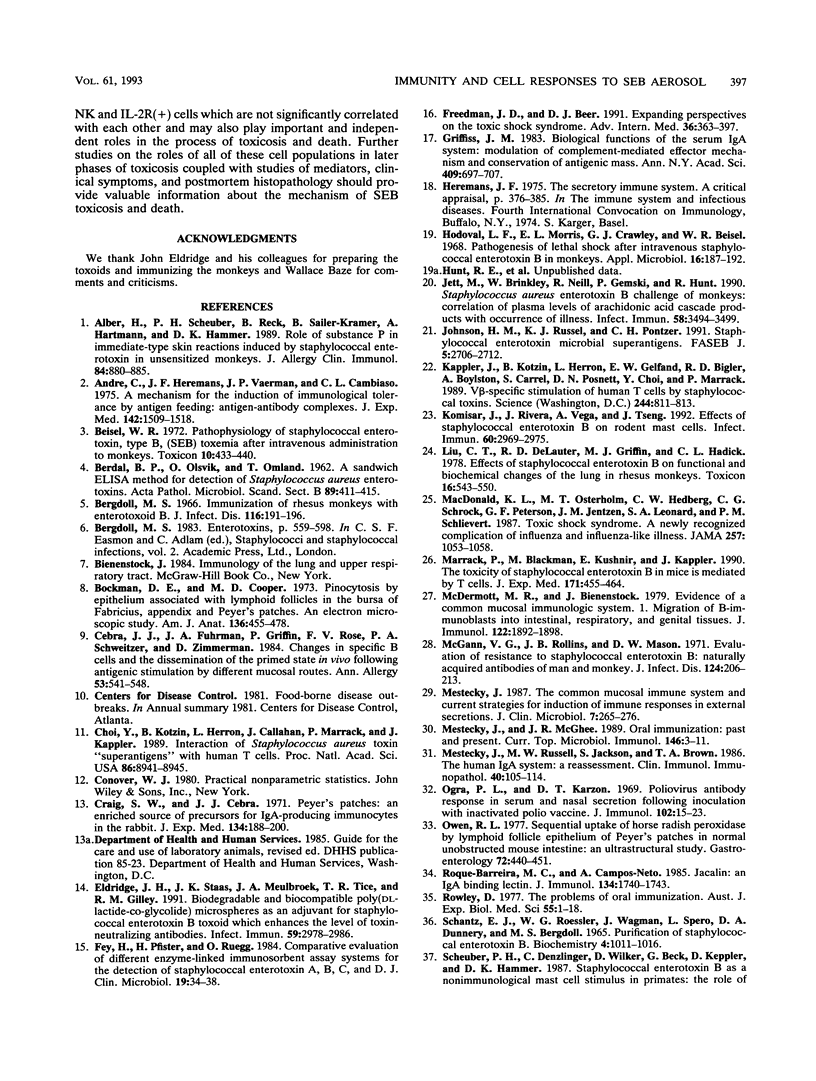
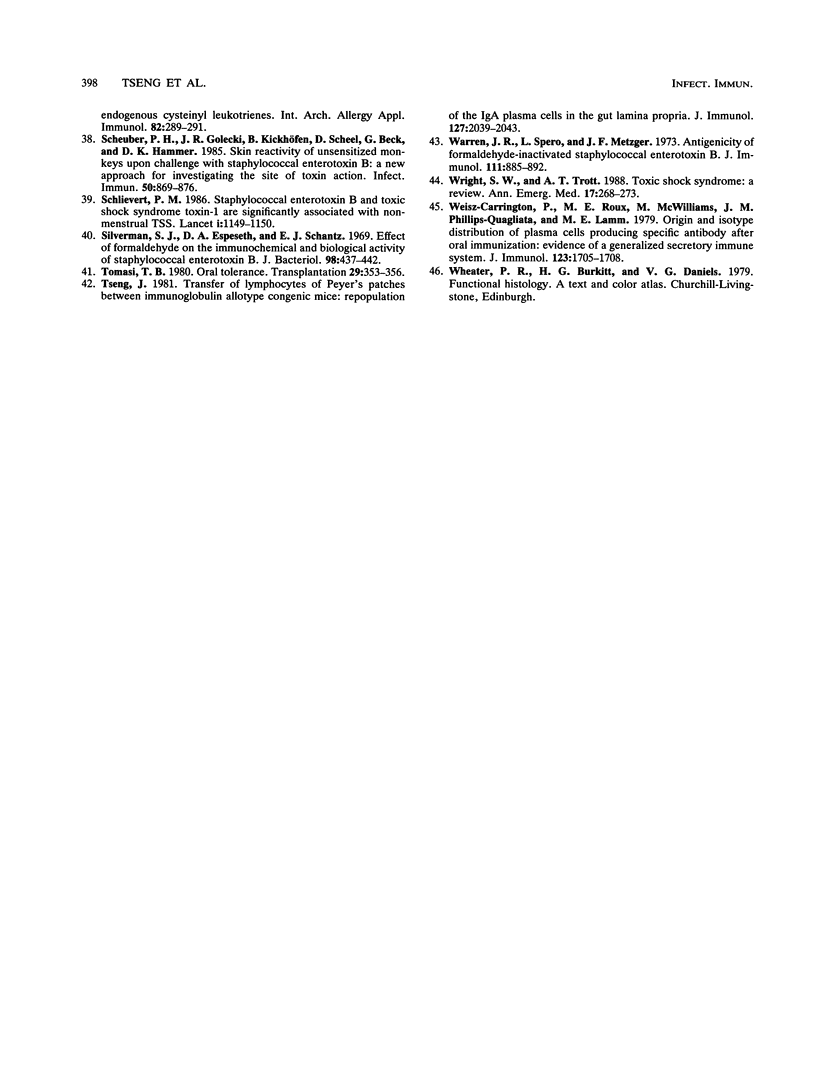
Selected References
These references are in PubMed. This may not be the complete list of references from this article.
- Alber G., Scheuber P. H., Reck B., Sailer-Kramer B., Hartmann A., Hammer D. K. Role of substance P in immediate-type skin reactions induced by staphylococcal enterotoxin B in unsensitized monkeys. J Allergy Clin Immunol. 1989 Dec;84(6 Pt 1):880–885. doi: 10.1016/0091-6749(89)90383-7. [DOI] [PubMed] [Google Scholar]
- André C., Heremans J. F., Vaerman J. P., Cambiaso C. L. A mechanism for the induction of immunological tolerance by antigen feeding: antigen-antibody complexes. J Exp Med. 1975 Dec 1;142(6):1509–1519. doi: 10.1084/jem.142.6.1509. [DOI] [PMC free article] [PubMed] [Google Scholar]
- Beisel W. R. Pathophysiology of staphylococcal enterotoxin, type B, (SEB) toxemia after intravenous administration to monkeys. Toxicon. 1972 Aug;10(5):433–440. doi: 10.1016/0041-0101(72)90167-5. [DOI] [PubMed] [Google Scholar]
- Berdal B. P., Olsvik O., Omland T. A sandwich ELISA method for detection of Staphylococcus aureus enterotoxins. Acta Pathol Microbiol Scand B. 1981 Dec;89(6):411–415. [PubMed] [Google Scholar]
- Bergdoll M. S. Immunization of Rhesus monkeys with enterotoxoid B. J Infect Dis. 1966 Apr;116(2):191–196. doi: 10.1093/infdis/116.2.191. [DOI] [PubMed] [Google Scholar]
- Bockman D. E., Cooper M. D. Pinocytosis by epithelium associated with lymphoid follicles in the bursa of Fabricius, appendix, and Peyer's patches. An electron microscopic study. Am J Anat. 1973 Apr;136(4):455–477. doi: 10.1002/aja.1001360406. [DOI] [PubMed] [Google Scholar]
- Cebra J. J., Fuhrman J. A., Griffin P., Rose F. V., Schweitzer P. A., Zimmerman D. Changes in specific B cells and the dissemination of the primed state in vivo following antigenic stimulation by different mucosal routes. Ann Allergy. 1984 Dec;53(6 Pt 2):541–549. [PubMed] [Google Scholar]
- Choi Y. W., Kotzin B., Herron L., Callahan J., Marrack P., Kappler J. Interaction of Staphylococcus aureus toxin "superantigens" with human T cells. Proc Natl Acad Sci U S A. 1989 Nov;86(22):8941–8945. doi: 10.1073/pnas.86.22.8941. [DOI] [PMC free article] [PubMed] [Google Scholar]
- Craig S. W., Cebra J. J. Peyer's patches: an enriched source of precursors for IgA-producing immunocytes in the rabbit. J Exp Med. 1971 Jul 1;134(1):188–200. doi: 10.1084/jem.134.1.188. [DOI] [PMC free article] [PubMed] [Google Scholar]
- Eldridge J. H., Staas J. K., Meulbroek J. A., Tice T. R., Gilley R. M. Biodegradable and biocompatible poly(DL-lactide-co-glycolide) microspheres as an adjuvant for staphylococcal enterotoxin B toxoid which enhances the level of toxin-neutralizing antibodies. Infect Immun. 1991 Sep;59(9):2978–2986. doi: 10.1128/iai.59.9.2978-2986.1991. [DOI] [PMC free article] [PubMed] [Google Scholar]
- Fey H., Pfister H., Rüegg O. Comparative evaluation of different enzyme-linked immunosorbent assay systems for the detection of staphylococcal enterotoxins A, B, C, and D. J Clin Microbiol. 1984 Jan;19(1):34–38. doi: 10.1128/jcm.19.1.34-38.1984. [DOI] [PMC free article] [PubMed] [Google Scholar]
- Freedman J. D., Beer D. J. Expanding perspectives on the toxic shock syndrome. Adv Intern Med. 1991;36:363–397. [PubMed] [Google Scholar]
- Griffiss J. M. Biologic function of the serum IgA system: modulation of complement-mediated effector mechanisms and conservation of antigenic mass. Ann N Y Acad Sci. 1983 Jun 30;409:697–707. doi: 10.1111/j.1749-6632.1983.tb26909.x. [DOI] [PubMed] [Google Scholar]
- Hodoval L. F., Morris E. L., Crawley G. J., Beisel W. R. Pathogenesis of lethal shock after intravenous staphylococcal enterotoxin B in monkeys. Appl Microbiol. 1968 Feb;16(2):187–192. doi: 10.21236/ad0666852. [DOI] [PMC free article] [PubMed] [Google Scholar]
- Jett M., Brinkley W., Neill R., Gemski P., Hunt R. Staphylococcus aureus enterotoxin B challenge of monkeys: correlation of plasma levels of arachidonic acid cascade products with occurrence of illness. Infect Immun. 1990 Nov;58(11):3494–3499. doi: 10.1128/iai.58.11.3494-3499.1990. [DOI] [PMC free article] [PubMed] [Google Scholar]
- Johnson H. M., Russell J. K., Pontzer C. H. Staphylococcal enterotoxin microbial superantigens. FASEB J. 1991 Sep;5(12):2706–2712. doi: 10.1096/fasebj.5.12.1916093. [DOI] [PubMed] [Google Scholar]
- Kappler J., Kotzin B., Herron L., Gelfand E. W., Bigler R. D., Boylston A., Carrel S., Posnett D. N., Choi Y., Marrack P. V beta-specific stimulation of human T cells by staphylococcal toxins. Science. 1989 May 19;244(4906):811–813. doi: 10.1126/science.2524876. [DOI] [PubMed] [Google Scholar]
- Komisar J., Rivera J., Vega A., Tseng J. Effects of staphylococcal enterotoxin B on rodent mast cells. Infect Immun. 1992 Jul;60(7):2969–2975. doi: 10.1128/iai.60.7.2969-2975.1992. [DOI] [PMC free article] [PubMed] [Google Scholar]
- Liu C. T., DeLauter R. D., Griffin M. J., Hadick C. L. Effects of staphylococcal enterotoxin B on functional and biochemical changes of the lung in rhesus monkeys. Toxicon. 1978;16(6):543–550. doi: 10.1016/0041-0101(78)90181-2. [DOI] [PubMed] [Google Scholar]
- MacDonald K. L., Osterholm M. T., Hedberg C. W., Schrock C. G., Peterson G. F., Jentzen J. M., Leonard S. A., Schlievert P. M. Toxic shock syndrome. A newly recognized complication of influenza and influenzalike illness. JAMA. 1987 Feb 27;257(8):1053–1058. doi: 10.1001/jama.257.8.1053. [DOI] [PubMed] [Google Scholar]
- Marrack P., Blackman M., Kushnir E., Kappler J. The toxicity of staphylococcal enterotoxin B in mice is mediated by T cells. J Exp Med. 1990 Feb 1;171(2):455–464. doi: 10.1084/jem.171.2.455. [DOI] [PMC free article] [PubMed] [Google Scholar]
- McDermott M. R., Bienenstock J. Evidence for a common mucosal immunologic system. I. Migration of B immunoblasts into intestinal, respiratory, and genital tissues. J Immunol. 1979 May;122(5):1892–1898. [PubMed] [Google Scholar]
- McGann V. G., Rollins J. B., Mason D. W. Evaluation of resistance to staphylococcal enterotoxin B: naturally acquired antibodies of man and monkey. J Infect Dis. 1971 Aug;124(2):206–213. doi: 10.1093/infdis/124.2.206. [DOI] [PubMed] [Google Scholar]
- Mestecky J., McGhee J. R. Oral immunization: past and present. Curr Top Microbiol Immunol. 1989;146:3–11. doi: 10.1007/978-3-642-74529-4_1. [DOI] [PubMed] [Google Scholar]
- Mestecky J., Russell M. W., Jackson S., Brown T. A. The human IgA system: a reassessment. Clin Immunol Immunopathol. 1986 Jul;40(1):105–114. doi: 10.1016/0090-1229(86)90073-5. [DOI] [PubMed] [Google Scholar]
- Mestecky J. The common mucosal immune system and current strategies for induction of immune responses in external secretions. J Clin Immunol. 1987 Jul;7(4):265–276. doi: 10.1007/BF00915547. [DOI] [PubMed] [Google Scholar]
- Ogra P. L., Karzon D. T. Poliovirus antibody response in serum and nasal secretions following intranasal inoculation with inactivated poliovaccine. J Immunol. 1969 Jan;102(1):15–23. [PubMed] [Google Scholar]
- Owen R. L. Sequential uptake of horseradish peroxidase by lymphoid follicle epithelium of Peyer's patches in the normal unobstructed mouse intestine: an ultrastructural study. Gastroenterology. 1977 Mar;72(3):440–451. [PubMed] [Google Scholar]
- Roque-Barreira M. C., Campos-Neto A. Jacalin: an IgA-binding lectin. J Immunol. 1985 Mar;134(3):1740–1743. [PubMed] [Google Scholar]
- Rowley D. The problems of oral immunisation. Aust J Exp Biol Med Sci. 1977 Feb;55(1):1–18. doi: 10.1038/icb.1977.1. [DOI] [PubMed] [Google Scholar]
- Schantz E. J., Roessler W. G., Wagman J., Spero L., Dunnery D. A., Bergdoll M. S. Purification of staphylococcal enterotoxin B. Biochemistry. 1965 Jun;4(6):1011–1016. doi: 10.1021/bi00882a005. [DOI] [PubMed] [Google Scholar]
- Scheuber P. H., Golecki J. R., Kickhöfen B., Scheel D., Beck G., Hammer D. K. Skin reactivity of unsensitized monkeys upon challenge with staphylococcal enterotoxin B: a new approach for investigating the site of toxin action. Infect Immun. 1985 Dec;50(3):869–876. doi: 10.1128/iai.50.3.869-876.1985. [DOI] [PMC free article] [PubMed] [Google Scholar]
- Schlievert P. M. Staphylococcal enterotoxin B and toxic-shock syndrome toxin-1 are significantly associated with non-menstrual TSS. Lancet. 1986 May 17;1(8490):1149–1150. doi: 10.1016/s0140-6736(86)91859-3. [DOI] [PubMed] [Google Scholar]
- Silverman S. J., Espeseth D. A., Schantz E. J. Effect of formaldehyde on the immunochemical and biological activity of staphylococcal enterotoxin B. J Bacteriol. 1969 May;98(2):437–442. doi: 10.1128/jb.98.2.437-442.1969. [DOI] [PMC free article] [PubMed] [Google Scholar]
- Tomasi T. B., Jr Oral tolerance. Transplantation. 1980 May;29(5):353–356. doi: 10.1097/00007890-198005000-00001. [DOI] [PubMed] [Google Scholar]
- Tseng J. Transfer of lymphocytes of Peyer's patches between immunoglobulin allotype congenic mice: repopulation of the IgA plasma cells in the gut lamina propria. J Immunol. 1981 Nov;127(5):2039–2043. [PubMed] [Google Scholar]
- Warren J. R., Spero L., Metzger J. F. Antigenicity of formaldehyde-inactivated staphylococcal enterotoxin B. J Immunol. 1973 Sep;111(3):885–892. [PubMed] [Google Scholar]
- Weisz-Carrington P., Roux M. E., McWilliams M., PHILLIPS-Quagliata J. M., Lamm M. E. Organ and isotype distribution of plasma cells producing specific antibody after oral immunization: evidence for a generalized secretory immune system. J Immunol. 1979 Oct;123(4):1705–1708. [PubMed] [Google Scholar]
- Wright S. W., Trott A. T. Toxic shock syndrome: a review. Ann Emerg Med. 1988 Mar;17(3):268–273. doi: 10.1016/s0196-0644(88)80121-5. [DOI] [PubMed] [Google Scholar]


